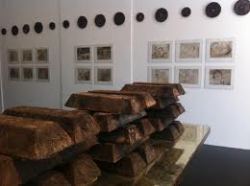Claire Penticost
 “Proposal for a New American Agriculture: Vermicomposted Cotton Flag
“Proposal for a New American Agriculture: Vermicomposted Cotton Flag
1. The center of the installation itself is the proposal of a new system of value based on living soil. To formalize this I have created a series “sculptural” objects from handmade soil, or compost. These represent units of a new currency, the soil-erg (provisional name), proposed as a replacement of the petro-dollar. In 1971, when U.S. President Richard Nixon ended trading of gold at a fixed price, formal links between the major world currencies and real commodities were severed. The gold standard was followed by a system of fiat currencies.
However, by 1973, Georgetown University economist Ibrahim Oweiss needed to coin the term “petrodollars” to describe the extraordinary significance of the circuit of capital running between a single commodity–crude oil–and a single currency–the U.S. dollar. While not formally fixed to international monetary values, the price of petroleum is the most determining value in the world economy. The dollar is an abstraction of value, the ultimate rendering of equivalence enabling all other commodities to be traded and circulated on a global market. Money as we know it has an obliterating function: it lets you forget all the human and nonhuman effort it takes to sustain life.
The important thing about the soil-erg is that it both is and is not an abstraction. Symbolically it refers to a field of value, but that value is of a special nature: it must be produced and maintained in a context. It is completely impractical to circulate it. It is heavy, and because of the loose structure required of good soil, it falls apart. It only makes sense when located in a place. The physical nature of the soil-erg both evokes and denies the possibility of coinage. If currency as we know it is the ultimate deterritorialization, the soil-erg is inherently territorialized. The forms of the objects themselves, large discs and stacks of ingots, reference the aesthetics of modernist serial abstraction. And yet just as the edifice of modernism is riddled with the cracks of unsustainability, they will eventually be subject to the entropic course of all organic matter.
From: http://www.publicamateur.org/
My first introduction to Claire Pentecost was in the zine Call To Farms, which can be found here:
“if you want environmental sustainability, work for social justice. As long as we segregate the risks and rewards of environmentally toxic industrialization, sustainability remains a specious marketing idea.”
A worthwhile interview can be found here: http://blog.art21.org/2012/01/31/5-questions-for-contemporary-practice-with-claire-pentecost/#.Ur8AQfvEqt8
“So much is needed, it’s a challenge to determine where to focus. The way to make a sustainable practice is to structure one’s contributions within the scope of one’s own needs and proclivities but with the aim of self-surpassing.”
And this exciting question, “Is the Bio- in BioArt the Bio- in Biopolitics?” is explored here:http://eipcp.net/transversal/0507/pentecost/en/base_edit
